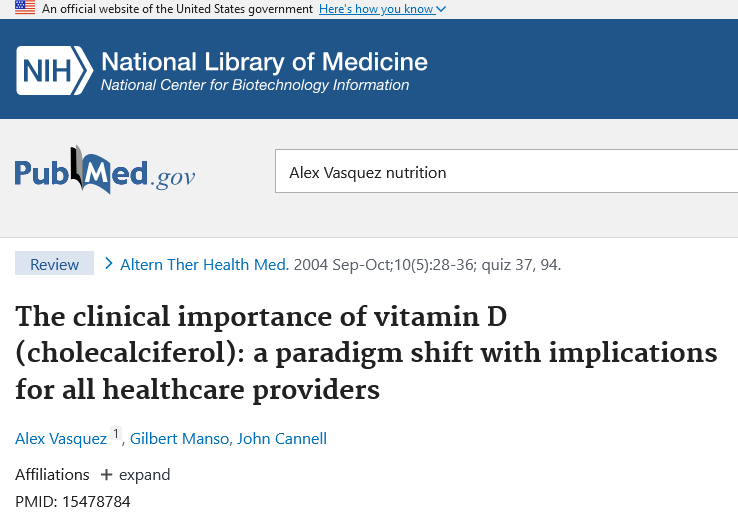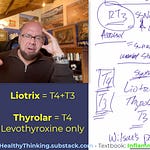Vitamin D Paradigm Shift summary: Vasquez 2025
Vitamin D combines with the vitamin D receptor (VDR) together functioning as a gene transcription factor directly binding to nuclear DNA and regulating the transcription of more than 1,000 genes or approximately 3% of the human genome.
For these reasons and others (such as its impact on the gut microbiome, neuroinflammation, mucosal/barrier defense, microbial/antiviral defense, mitochondrial performance, muscle function, immunomodulation/autoimmunity), we now appreciate that vitamin D is a keystone/cornerstone physiologic factor that impacts systemic health; deficiency of vitamin D therefore negatively impacts numerous body systems and can result in a wide range of disorders and diseases.
By now, we have clear evidence—both mechanistically and clinically—of the importance of vitamin D supplementation in the prevention and treatment of 1) chronic pain such as migraine, low-back pain [VIDEO], 2) depression and anxiety [VIDEO], 3) barrier defense against allergy and inflammation [VIDEO] [this current page; video above], 4) vitamin D in anti-inflammation and immunomodulation [VIDEO], 5) vitamin D against infections; vitamin D supports antiviral defense [VIDEO]
THE TASK THAT WAS GIVEN TO ME by the journal Alternative Therapies in Health and Medicine was to write an article about vitamin D; the catch was that I had to start from zero and had to have the article ready for publication within 8-10 days. This task was given to me, and I carried it forward with considerable success:
Vasquez A, Manso G, Cannell J. The clinical importance of vitamin D (cholecalciferol): a paradigm shift with implications for all healthcare providers. Altern Ther Health Med. 2004 Sep-Oct;10(5):28-36; quiz 37, 94. PMID: 15478784.
Getting by with a little help from my friends:
For the article to qualify for continuing medical education credits (CME), I had to have a co-author who was an “MD” despite that I was writing the article by myself, already had two doctorates with extensive training and practice in nutrition, and MDs have no formal training in nutrition. (This was in 2004, and even though I had already been accepted to medical school, I deferred for two years to give me time to close my private practice and get other details in order.) During these years from ~2001-2006, I was fortunate to be sharing office space with Gilbert Manso MD, and he agreed to read the final draft and put his name on the paper.
PDF compilation of my vitamin D articles is provided for free below
I wrote, read, and photocopied articles at the Texas Medical Center library nonstop for 8 days. Practically at the last minute, I sent the paper to John Cannell MD, who skillfully (and thankfully) added the sections on Diabetes and Hypertension. I thought that the bottom of our optimal range for vitamin D should be 50 ng/ml (125 nmol/L) but John (who had more social-political experience on the topic) said that would be perceived as too radical and he advised that we use 40 ng/ml (100 nmol/L) so that our ideas would find greater acceptance and not be rejected outright. In a separate paper that I authored in 2011 (Revisiting the five-part nutritional wellness protocol: the supplemented Paleo Mediterranean diet. Nutritional Perspectives 2011 Jan), I stated that bottom of the optimal range for vitamin D should be 50 ng/ml (125 nmol/L); ten years later in 2020, this was more widely accepted as correct (Rastogi et al, BMJ’s Postgraduate Medicine Journal 2020 Nov).
In 2005, I published most of our main conclusions in a letter/reply posted on the website of THE LANCET, back when THE LANCET was a respectable publication, ie, before it sold its soul to the globalists. Also in 2005, John and I published a letter/reply at the request of BRITISH MEDICAL JOURNAL which contained our major 6 points:
We provided six guidelines for interventional studies with vitamin D.
Dosages of vitamin D must reflect physiological requirements and natural endogenous production and should therefore be in the range of 3000-10 000 IU daily.
Vitamin D supplementation must be continued for at least five to nine months.
The form of vitamin D should be D3 rather than D2.
Supplements should be assayed for potency.
Effectiveness of supplementation must include measurement of serum 25-hydroxyvitamin D.
Serum 25(OH)D concentrations must enter the optimal range, which is 40-65 ng/ml (100-160 nmol/l).
Standing on the shoulders of giants:
The strongest authors and their papers at that time were Heaney, Zitterman, and Vieth. Vieth proved the safety. Heaney proved the dose. Zitterman basically asked “What the fvck are we waiting on?” and I answered his question by asserting that we were overdue for a paradigm shift.
Vieth R. Vitamin D supplementation, 25-hydroxyvitamin D concentrations, and safety. Am J Clin Nutr. 1999 May;69(5):842-56. doi: 10.1093/ajcn/69.5.842
Zittermann A. Vitamin D in preventive medicine: are we ignoring the evidence? Br J Nutr. 2003 May;89(5):552-72. doi: 10.1079/BJN2003837
Heaney RP, Davies KM, Chen TC, Holick MF, Barger-Lux MJ. Human serum 25-hydroxycholecalciferol response to extended oral dosing with cholecalciferol. Am J Clin Nutr. 2003 Jan;77(1):204-10. doi: 10.1093/ajcn/77.1.204
We’ve come a long way, baby:
By now, we’ve gained a detailed understanding of the mechanisms and importance of vitamin D, and—whereas back in 2004 we had only a handful of mostly underdosed studies—we now have a mountain of quality evidence and clinical trials. I’ve reviewed this data in many articles and videos which can mostly be categorized as follows:
VIDEO REVIEW: Vitamin D against neuroinflammation, dysbiosis, and CHRONIC PAIN.
VIDEO REVIEW: Vitamin D against neuroinflammation and MOOD DISORDERS, DEPRESSION, ANXIETY.
VIDEO REVIEW: Vitamin D support for barrier/mucosal defense, which is important against SYSTEMIC INFLAMMATION, ALLERGY AND AUTOIMMUNITY.
VIDEO REVIEW: Vitamin D deficiency promotes disorders of INFLAMMATION AND COAGULATION.
VIDEO REVIEW: Importance of vitamin D in immune defense and especially against viral infections.
All of those video reviews are hyperlinked and available for viewing.
PDF compilation of my vitamin D articles is provided here
Also noted:
Vasquez A. Rapid Response: Scotland's public health programs and trends improving nutritional status should be considered when discussing HPV trends. https://www.bmj.com/content/365/bmj.l1375/rr-4 11April2019
Vasquez A. Rapid Response: Scotland's public health campaigns to improve vitamin D nutriture occurred within the same timeframe as HPV vaccination. https://www.bmj.com/content/365/bmj.l1161/rr-8 13April2019
See all of my major Vitamin D videos all archived on this page linked below as “Vitamin D goldmine”
Vitamin D GOLDMINE: 13 PDFs (compiled together) + 7 hours in 8 Videos
Now that you are an expert on the anti-inflammatory, antiviral, psychiatric, and metabolic use of NAC-acetylcysteine, now you can extend your expertise to vitamin D.
Vitamin D in Brain Health, Mood, Anxiety, Depression, Neuroprotection [archived, goldmine2, #BrainHealthOptimization series]
This video was provided in its entirety FOR FREE for a generous period of time but is now reserved for supporting subscribers; to get free access to new videos, be sure you are subscribed









![Vitamin D in Brain Health, Mood, Anxiety, Depression, Neuroprotection [archived, goldmine2, #BrainHealthOptimization series]](https://substackcdn.com/image/fetch/$s_!7B4z!,w_1300,h_650,c_fill,f_auto,q_auto:good,fl_progressive:steep,g_auto/https%3A%2F%2Fsubstack-video.s3.amazonaws.com%2Fvideo_upload%2Fpost%2F153129140%2F5e96f8a1-2c48-4ae6-b95c-86e1b199dde8%2Ftranscoded-1734203333.png)









Share this post